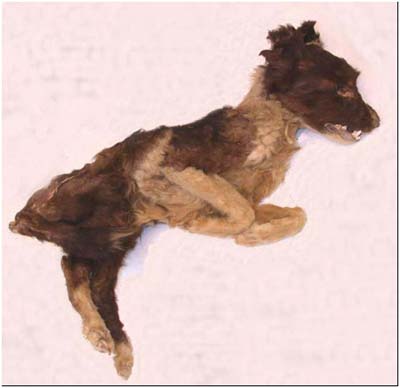Ancient dogs play a role in bringing the deceased to the afterlife
Hundreds of prehistoric dogs excavated throughout southwestern America show that dogs and animals play an important role in ancient American beliefs.
According to Dody Fugate, manager at the Indian Museum of Arts & Culture in Santa Fe, New Mexico, throughout the area, dogs were found buried with jewelry, next to adults and children, carefully arranged in groups or placed in positions related to important structures.
Fugate is conducting a survey of burying dogs in the area, and the finding shows that this animal occupies a more prominent position in the owner's life than a pet's own.
'I think dogs in the New World in the southwest region are used to send people to the afterlife and sometimes they are also present in certain ceremonies in human positions.'
To carry out his research, Fugate collected data on burial sites and reminded his archaeological colleagues to record their discoveries in the excavation process.
'I had data for nearly 700 dog burial areas, a majority of these were buried in sacred places or buried with people .'
Many burial sites are concentrated in southwestern New Mexico and along the Arizona-Mexico border. ' The whole area is full of groups of people and dogs.'
Fugate presented his findings at the annual meeting of the American Archaeological Community in Vancouver, Canada in March.

A natural dog mummy was unearthed in Arizona in 1921, one of 700 dogs discovered buried in southwestern America.The new study on dog burial practices suggests that dog animals play an important role in the beliefs of ancient Americans.( Photo: Dody Fugate)
History of 1,900 years of burial
Fugate's data shows that the most common burying of dogs dates from 400 BC to 1100 AD.
Fugate said, 'The older the graves, the more likely it is to discover dogs buried with them.' Until the 1400s and 1500s, the burying of dogs according to him stopped. In fact, the Pueblo and Navajo Indians today believe that burying dogs is wrong.
The appearance of ancient dogs is still an open question, but the remnants show that they are more diverse than people think.
Fugate witnessed the legacy of ancient dogs with soft ears and pointed ears, long tails or twisted tails, small or thin body and lanky.
There are even discovered white dogs buried along the Arizona-Utah border. Their fur is used to weave ritual clothes.
She concluded 'They are really diverse.'
Dogs - important objects of archaeologists?
Susan Crockford is an paleontologist at Victoria University, Canada, studying dog breeds in the Pacific Northwest. She agrees that dogs' bodies are often overlooked during archaeological excavations.
Archaeologists often test animal bones at the excavation site with the idea of what food the ancient people used rather than the relationship between humans and dogs.
'Because these dogs do not appear as food sources, they are often overlooked with the thought that they are nothing important . so the details recorded about them are negligible.'
Crockford believes that the spiritual role of dogs is one of their most important functions in the region, perhaps second only to the role of hunting and herding.
Fugate said the data she collected will give the dog a key role in understanding the past.
'Do not believe that dogs can have a religious relationship with humans also means that people are missing out on a large part of ancient religion. If we do not believe in this possibility, we may lose a great amount of information about ancient beliefs and thoughts of the ancients. '
- What do ancient people do to bring souls to the afterlife?
- Dogs are also 'allergic' to injustice
- Why do the Egyptians marvel?
- Zinc may play a key role in eye disease
- Home dogs originated from European wolves
- Unexpected discovery of dog loyalty
- What animals did the ancient Egyptians worship?
- Genes play an important role in making a difference in male and female behavior
- Domestic dogs are formed by the 'landfill'.
- Egypt found the door to the afterlife
- Why should we feel guilty?
- The most beautiful breeds in the world
 Discovered an ancient centipede fossil 99 million years old
Discovered an ancient centipede fossil 99 million years old Discovered bat-like dinosaurs in China
Discovered bat-like dinosaurs in China Discovered a 200-year-old bronze cannon of the coast
Discovered a 200-year-old bronze cannon of the coast Discover 305 million-year-old spider fossils
Discover 305 million-year-old spider fossils Why can geese guard the house instead of dogs?
Why can geese guard the house instead of dogs?  The secret of the dog barking on top of the pyramid in Egypt
The secret of the dog barking on top of the pyramid in Egypt  With a bear face, fox mouth, webbed feet and cat-like teeth, is the Bush dog really a type of dog?
With a bear face, fox mouth, webbed feet and cat-like teeth, is the Bush dog really a type of dog?  The 'glittery eyes' of domestic dogs are not due to evolution
The 'glittery eyes' of domestic dogs are not due to evolution  Video: Kangaroo 'fight' with domestic dog and unexpected ending
Video: Kangaroo 'fight' with domestic dog and unexpected ending  Signs of a rabid dog
Signs of a rabid dog 